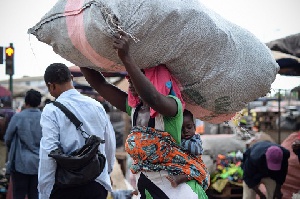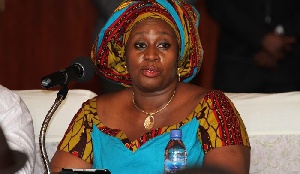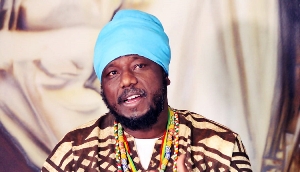For Adiza, a head-porter who hails from the Northern Region, engaging tiring work in the capital is not a choice but imperative for her family’s survival back home.
“I am here to work. I am doing ‘kayaye’ because I am from a poor family. So, I am doing this to support the family. Kayeye is very hard work because at times you charge GH¢3 but most people will look you in the face and give you GH¢1 – which is very bad.
“I have no option than to sell on the street. At times I wish I was home with my parents; I have been missing them every day.”
Her story echoes that of many more street-children the B&FT spoke to. Eric Eyan, a 16-year old who sells sachet water at Makola said: “I am selling on the street because my father is not taking good care of me. I am doing this to support my education. My father does not pay my school fees, I do everything by myself; from buying books to uniforms and other things, so I am doing this to cater for myself”.
Kwesi Ankrah, a 16-year-old who hails from Ashanti Region but works as a truckpusher in Amasaman, a suburb of Accra, said: “My parents are dead and I have nobody to help me further my education, so I am doing this to support my education.”
The Ghana Statistical Service (GSS) estimates that the total number of street-children in the Greater Accra Region is about 90,000.
Five thousand, seven hundred and sixty-eight (5,768) street-children were counted in the Ashaiman, Nungua Municipalities and Tema Metropolitan area, while 939 were in the Ga West Metropolitan.
Two thousand and thirty-one (2,031) children were also counted in the Danbge West district. In Accra Metropolitan area, 50,997 children were counted. The phenomenon is no different in Madina – the Ga East Municipal area – where 1,757 children were counted.
The data indicate that 28.5% of the children were from the Northern Region; 19.5% from Greater Accra; 10.2% were from Volta Region; 7.5% from Upper East Region; and 7.3% from Ashanti Region.
The rest are Central Region, 6%; Upper West, 2.9%; and Western Region, 2.4% – and foreign nationals accounted for about 3%. The huge numbers involved reveals the failure of the country’s safety net
Sewing, a 17-year-old Sierra Leonean, who hawks sachet-water on the street of Accra, said that selling water on the streets of the capital is his only means of survival because he has nobody to support him.
“I have nobody in the country, so I am selling so that I take good care of myself. I use the money to pay my hospital bills, house bill, cloth and many more.”
Kwesi Kubi, a 15-year old from Akuapem in the Eastern Region, is a Fan-milk seller and said he hawks because his father has an eye problem and needs to be operated on.
“I am engaged in fan-milk business to support my father’s operation. He needs a lot of money to do the operation. My mother is dead and I have no elder siblings to support me.’’
According to Abdul Karim, a 14-year old Nigerian who sells popcorn, he sells on the street because he cannot beg for food and money. “I am selling to avoid stealing and begging on the street.”
“I normally come here during vacations to sell sachet-water, because my parent are divorced and due to that paying my school fees has been a problem. So, I am selling to support my education. My dream is to become a nurse; I will work hard to achieve that dream,” said Anita Osei, a 15-year old sachet-water seller from the Ashanti Region.
The Ministry of Gender and Social Protection must lead the charge to stem the tide and provide decent social housing, and facilitate the re-admission of street-children back into school.
Further strict enforcement of the country’s many social protection laws and investing in children homes that can serve as temporary shelters ought to be given serious consideration.
Opinions of Tuesday, 25 September 2018
Columnist: thebftonline.com















